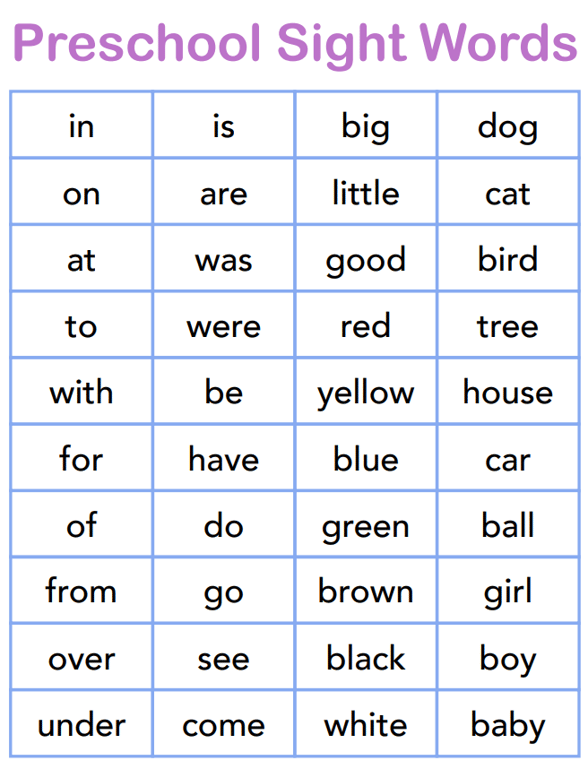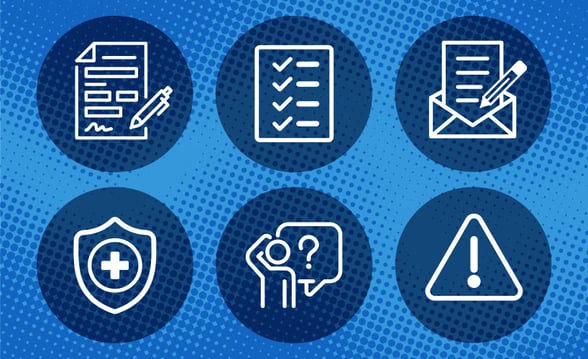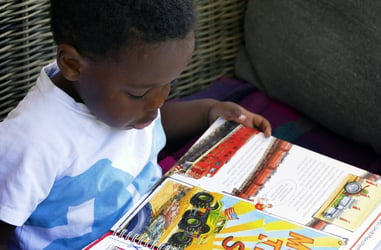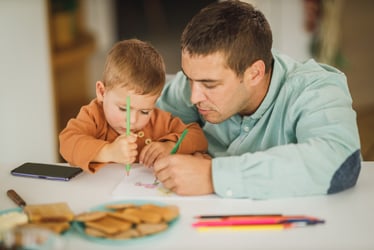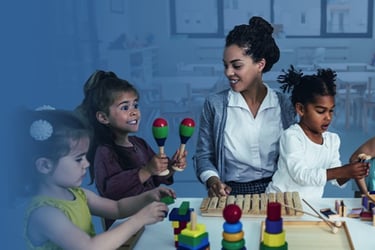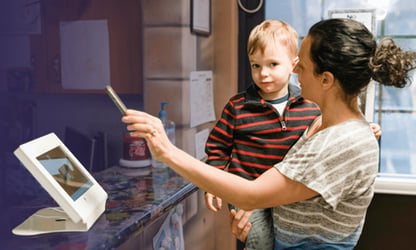Discover the secret weapon that can skyrocket preschooler reading skills: sight words. These high-frequency words are the building blocks of pre-K literacy and mastering them can make a world of difference. In this must-read article, you'll learn why sight words are crucial, which words your children should know and fun activities to help them learn. Don't miss out on this opportunity to set your students up for reading success!
Table of Contents
- What Are Sight Words for Preschool?
- Why Are Sight Words Important for Preschoolers?
- What Sight Words Should Preschoolers Know?
- How to Teach Sight Words for Preschool
- Preschool Sight Word Activities for the Classroom
- Preschool Dolch Sight Words FAQs
What Are Sight Words for Preschool?
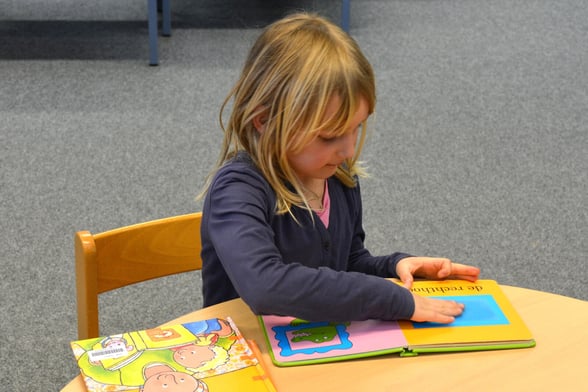
Sight words are common words that children should recognize instantly without the need for decoding. These words frequently appear in children's literature and are essential for building reading fluency. Examples of common sight words include "the," "and," "is," and "you." Frequently, you'll hear the phrase "Dolch words" or "Dolch sight words." Edward William Dolch was a professor and author at the University of Illinois. He's known for creating a sight word list, 220 in total, detailing high-frequency vocabulary words used in children's books. Because children start learning reading through books, mastering these lists of words helps set students up for long-term academic success.
Why Are Sight Words Important for Preschoolers?
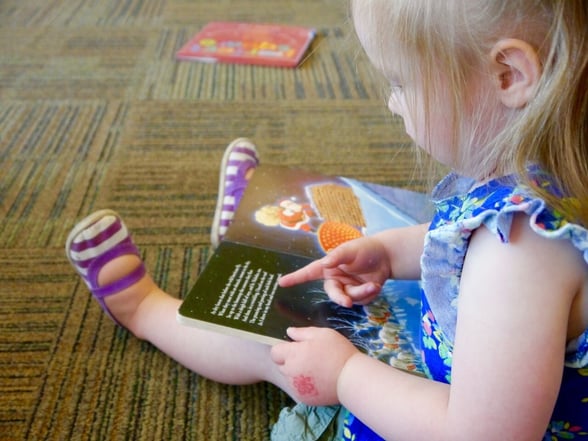
Sight words play a crucial role in early literacy development. When children can recognize sight words quickly, they read more fluently and comprehend text better. Knowing sight words boosts children's confidence in reading, allowing them to focus on understanding the meaning of the text rather than struggling with decoding individual words. According to Dr. Timothy Shanahan, a literacy expert, building sight vocabulary in preschoolers can be beneficial when done in addition to essential early literacy skills like phonological awareness and concepts of print.
Research by St. Cloud State University highlights the importance of sight word instruction in improving reading fluency and comprehension. Additionally, the Iowa Reading Research Center emphasizes that teaching sight words should be part of a comprehensive reading instruction program that includes phonics, phonemic awareness and vocabulary development.
What Sight Words Should Preschoolers Know?
Here is a list of the top 40 Dolch sight words suitable for preschoolers, broken down by word type:
| Prepositions | Verbs | Adjectives | Nouns |
|---|---|---|---|
| in | is | big | dog |
| on | are | little | cat |
| at | was | good | bird |
| to | were | red | tree |
| with | be | yellow | house |
| for | have | blue | car |
| of | do | green | ball |
| from | go | brown | girl |
| over | see | black | boy |
| under | come | white | baby |
Looking for a Printable List of Sight Words?
We've built a free PDF for you can download for your preschool with the complete list of 40 sight words above.
How to Teach Sight Words for Preschool

Teaching sight words to preschoolers involves repetition, practice and incorporating sight words into daily reading activities. Here are some key strategies.
Incorporating Sight Words in the Preschool Curriculum
According to Ascend Learning Center, effective sight word instruction should be systematic, explicit and multisensory. Systematic instruction involves teaching sight words in a planned, sequential manner. Explicit instruction means directly teaching and modeling sight word recognition strategies. Multisensory approaches engage children's visual, auditory and kinesthetic senses to enhance learning. Recognizing new words is key as they are preparing for kindergarten and learning to read. Here are a few effective tactics you should consider as you teach your child to read:
- Repetition and practice are essential for learning sight words. Point out sight words in storybooks and encourage children to identify them.
- Use sight word flashcards, games and hands-on activities to reinforce learning.
- Integrate sight words into daily reading routines, such as shared reading and guided reading sessions.
Another thing you should consider when teaching Dolch preschool words is phonics. St. John Fisher University suggests that sight word instruction should be paired with phonics instruction to support overall reading development. While sight words are learned through memorization, phonics instruction helps children understand letter-sound relationships and develop decoding skills. Combining sight word and phonics instruction and learning activities creates a balanced approach to early literacy development.
Preschool Sight Word Activities for the Classroom
Sight Words for Preschool Worksheets
Preschool sight word worksheets can be an effective supplementary tool in the classroom when used alongside other activities. These worksheets provide additional practice and reinforcement of sight words. Here are some tips for using worksheets:
- Use worksheets as a follow-up activity after introducing new sight words.
- Encourage children to read the words aloud as they complete the worksheets.
- Help students see that learning sight words can be fun by incorporating coloring, tracing and matching activities in the worksheets to make them engaging.
You can find free, printable preschool sight word worksheets at:
Sight Words for Preschool Flash Cards
Sight word flashcards are an excellent tool for building word recognition skills. Benefits of using flashcards include:
- Providing visual cues for word recognition
- Allowing for repetition and practice
- Enabling a variety of activities and games using the flashcards
Vanco offers free sight word flashcards featuring the words from the list provided earlier. Click the image below to download them.
Engaging Preschoolers with Sight Word Games and Activities
Incorporating fun sight word games and activities makes literacy lessons enjoyable for preschoolers. Here are the top 10 activities designed to help preschoolers read by sight.
1. Sight Word Bingo
Overview: Sight Word Bingo is a classic game that reinforces word recognition and listening skills. Children match called-out sight words with those on their bingo cards.
Materials:
- Bingo cards with sight words (one per child)
- Sight word calling cards
- Markers or tokens
Setup:
- Create bingo cards with sight words in each square.
- Prepare a set of sight word calling cards.
- Provide each child with a bingo card and markers or tokens.
Instructions:
- Explain the rules of the game to the children.
- Draw sight word calling cards one at a time, reading the word aloud.
- Have children search for the called word on their bingo card and cover it with a marker or token.
- Continue calling words until a child covers a predetermined pattern (e.g., a row, column or diagonal) and shouts "Bingo!"
- Verify the winning card by having the child read back the covered words.
- Play additional rounds as time allows.
2. Sight Word Tracing
Overview: Tracing sight words using various materials provides a multisensory approach to learning, engaging children's visual, auditory and tactile senses.
Materials:
- Sand, shaving cream or finger paint
- Trays or shallow containers
- Sight word cards
- Paintbrushes (optional)
Setup:
- Pour sand, shaving cream or finger paint into trays or shallow containers.
- Display sight word cards near the trays.
Instructions:
- Demonstrate how to trace a sight word in the chosen material using a finger or paintbrush.
- Encourage children to select a sight word card and trace the word in the material.
- Have children say the word aloud as they trace it.
- Provide guidance and support as needed.
- Allow children to explore tracing multiple sight words.
- Discuss the traced words with the children, emphasizing their shapes and sounds.
3. Sight Word Hopscotch
Overview: Sight Word Hopscotch combines physical activity with sight word recognition, making learning active and enjoyable.
Materials:
- Sidewalk chalk
- Beanbag or small stone
- List of sight words
Setup:
- Draw a hopscotch board on the ground using sidewalk chalk.
- Write a sight word in each square of the hopscotch board.
Instructions:
- Explain the rules of hopscotch to the children.
- Have each child take turns tossing the beanbag or stone onto a square.
- The child then hops through the hopscotch board, avoiding the square with the beanbag.
- When the child reaches the end, they turn around and hop back, picking up the beanbag on their way.
- Upon picking up the beanbag, the student reads the sight word aloud.
- If the child correctly reads the word, they earn a point.
- Continue playing until all children have had multiple turns.
4. Sight Word Scavenger Hunt
Overview: A Sight Word Scavenger Hunt encourages children to actively search for and identify sight words in their environment.
Materials:
- Sight word cards
- Magnifying glasses (optional)
- Stickers or small prizes
Setup:
- Hide sight word cards around the classroom or outdoor play area.
- Provide each child with a magnifying glass (optional) and a list of sight words to find.
Instructions:
- Explain the rules of the scavenger hunt to the children.
- Have children search for the hidden sight word cards.
- When a child finds a card, they read the word aloud to a teacher or peer.
- If the child correctly reads the word, they earn a sticker or small prize.
- Continue the hunt until all words have been found or a predetermined time limit is reached.
- Gather the children and review the found sight words together.
5. Sight Word Mystery Box
Overview: The Sight Word Mystery Box activity adds an element of surprise and tactile exploration to sight word learning.
Materials:
- A box with a hand-sized hole cut into the lid
- Various small objects representing sight words (e.g., toy car for "car," plastic apple for "red")
- Sight word cards
Setup:
- Place the objects inside the mystery box.
- Arrange the corresponding sight word cards near the box.
Instructions:
- Introduce the Sight Word Mystery Box to the children.
- Have each child take turns reaching into the box and selecting an object (without looking).
- The child then feels the object and tries to guess what it is.
- After guessing, the child pulls out the object and matches it to the corresponding sight word card.
- The child reads the sight word aloud.
- Continue playing until all children have had multiple turns.
6. Sight Word Fishing
Overview: Sight Word Fishing turns sight word recognition into a fun, imaginative game that develops hand-eye coordination.
Materials:
- Stick or dowel rod
- String
- Magnet
- Paper clips
- Sight word fish cutouts (with a paper clip attached to each)
- Small bucket or container
Setup:
- Create a fishing rod by tying a string with a magnet to the end of the stick or dowel rod.
- Cut out fish shapes from paper and write a sight word on each fish.
- Attach a paper clip to each fish cutout.
- Place the fish cutouts in a small bucket or container.
Instructions:
- Demonstrate how to use the fishing rod to catch a fish.
- Have each child take turns using the fishing rod to catch a fish.
- When a child catches a fish, they read the sight word aloud.
- If the child correctly reads the word, they keep the fish.
- Continue playing until all fish have been caught or a predetermined time limit is reached.
- Have children count and compare the number of fish they caught.
7. Sight Word Snowball Fight
Overview: Sight Word Snowball Fight is an active, winter-themed game that encourages sight word recognition and gross motor skill development.
Materials:
- White paper
- Markers
- Scissors
- Soft foam balls or crumpled paper balls
Setup:
- Write sight words on white paper and cut them into snowball shapes.
- Tape the sight word snowballs around the classroom or play area.
Instructions:
- Divide the children into two teams.
- Provide each team with a set of soft foam balls or crumpled paper balls.
- Explain the rules of the snowball fight:
- Children take turns throwing the balls at the sight word snowballs.
- When a child hits a snowball, they retrieve it and read the sight word aloud.
- If the child correctly reads the word, their team earns a point.
- Set a time limit for the game and have the teams alternate turns.
- At the end of the game, tally the points and declare a winning team.
8. Sight Word Parking Lot
Overview: Sight Word Car Park integrates sight word learning with imaginative play, as children match toy cars to sight word parking spaces.
Materials:
- Toy cars
- Cardboard or foam sheets
- Markers
- Scissors
Setup:
- Cut the cardboard or foam sheets into parking space shapes.
- Write a sight word on each parking space.
- Arrange the parking spaces on the floor or a table.
Instructions:
- Provide each child with a toy car.
- Have the children take turns driving their cars to a parking space.
- When a child parks their car, they read the sight word aloud.
- If the child correctly reads the word, they leave their car in the parking space.
- Continue playing until all parking spaces are filled or each child has had multiple turns.
- Encourage the children to read the sight words on the occupied parking spaces.
9. Sight Word Bowling
Overview: Sight Word Bowling combines sight word practice with a classic game, developing hand-eye coordination and turn-taking skills.
Materials:
- Empty plastic bottles or foam blocks
- Ball
- Markers
- Stickers or labels
Setup:
- Write a sight word on each bottle or block using markers, stickers or labels.
- Arrange the bottles or blocks in a bowling pin formation.
Instructions:
- Have children take turns rolling the ball toward the sight word pins.
- When a child knocks down a pin, they read the sight word aloud.
- If the child correctly reads the word, they earn a point.
- Reset the pins after each turn.
- Continue playing until all children have had multiple turns.
- Tally the points at the end of the game and celebrate everyone's success.
10. Sight Word Twister
Overview: Sight Word Twister puts a learning spin on the classic game, encouraging children to stretch their bodies and minds while practicing sight words.
Materials:
- Twister mat or colored circles cut from paper
- Spinner or dice
- Sight word cards
Setup:
- Place the Twister mat or colored circles on the floor.
- Put a sight word card on each color of the mat or circle.
Instructions:
- Have children take turns spinning the spinner or rolling the dice to determine the color and body part (e.g., red, left hand).
- The child places the specified body part on the corresponding color.
- The child then reads the sight word on that color aloud.
- If the child correctly reads the word, they maintain their position on the mat.
- Continue playing until all children have had multiple turns or until everyone is tangled up.
- Encourage the children to help each other read the sight words while playing.
Preschool Dolch Sight Words FAQs
What words should a 4-year-old read?
According to the Victoria Department of Education and Early Childhood Development's report, 4-year-olds are typically developing their knowledge of letters and sounds. They may begin to recognize simple, high-frequency words such as their own name, "mom," "dad," and other familiar words. However, reading ability varies widely among children at this age and some may not yet be reading independently.
What is the average vocabulary of a 4-year-old?
The study, "Vocabulary size and auditory word recognition in preschool children" from Applied Psycholinguistics suggests that preschool-aged children recognize between 1,000 and 10,000 words. This wide range accounts for individual differences in language exposure and development.
Can the average 4-year-old read?
While some 4-year-olds may show an interest in reading and begin to recognize simple words, the average 4-year-old is not expected to read independently. The KidsHealth milestone checklist for 4-year-olds includes skills such as recognizing some letters, understanding that letters make up words and enjoying being read to, but not necessarily reading on their own. The Victoria Department of Education also notes that reading development varies widely among young children.
Get 100+ Editable and Printable Templates for Almost Every Preschool Situation
We know preschools like yours are busy. That's why we made dozens of templates to help you manage the various aspects of your organization. With billing and invoicing, activity templates, forms and even marketing materials, we have it all. Download all 100 today!
List of Preschool References
Ascend Learning Center. (n.d.). How to Teach Sight Words Using a Research-Based Approach. Retrieved from https://www.ascendlearningcenter.com/blog-highlights/research-based-sight-word-instruction
Dowling, C. M. (2014). The Effect of a Research-Based Intervention on the Sight Word Recognition of Students with Disabilities. Fisher Digital Publications. Retrieved from https://fisherpub.sjf.edu/cgi/viewcontent.cgi?article=1327&context=education_ETD_masters
Duursma, E., Augustyn, M., & Zuckerman, B. (2008). Reading aloud to children: the evidence. Archives of disease in childhood, 93(7), 554–557. https://doi.org/10.1136/adc.2006.106336
KidsHealth. (n.d.). Reading Milestones (for Parents). Nemours Children's Health. Retrieved from https://kidshealth.org/en/parents/milestones.html
Nemours Children's Health. (2008). Reading to Young Children: A Head-Start in Life. Melbourne Institute of Applied Economic and Social Research. Retrieved from https://www.education.vic.gov.au/documents/about/research/readtoyoungchild.pdf
Olson, E. (2016). The Effects of Sight Word Instruction on Students' Reading Abilities. Culminating Projects in Teacher Development. Retrieved from https://repository.stcloudstate.edu/cgi/viewcontent.cgi?article=1049&context=ed_etds
Reed, D. K., & Hinzman, M. (2018). Teaching Sight Words as a Part of Comprehensive Reading Instruction. Iowa Reading Research Center. Retrieved from https://irrc.education.uiowa.edu/blog/2018/06/teaching-sight-words-part-comprehensive-reading-instruction
Shanahan, T. (2019). Sight Vocabulary for Preschool. Reading Rockets. Retrieved from https://www.readingrockets.org/blogs/shanahan-on-literacy/sight-vocabulary-preschool





